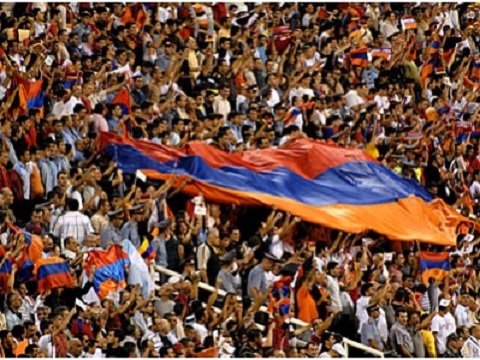The Armenian Weekly. The matter of how many people live on Armenian controlled land has been something I’ve wanted to address for quite some time. Yerevan’s recently enacted increase in benefits to families having more children provides just the context needed to broach this subject.
All the jokes about size mattering are no laughing matter when it comes to population. Without enough people, a country cannot have a strong military, a very pressing aspect of life for the Republic of Armenia given its hostile and belligerent neighbors. Intellectual life, innovation, cultural development and progress also rely on having a larger base of people for support.
Crucially, even the economy of a country is dependent on its population. At last year’s ANCA Western Region Grassroots Conference, Zareh Sinanian, the new Diaspora “minister” (I use the term for simplicity recognizing it is not his official title), noted that for the RoA to be sustainable, it must have a population of five million by 2050 (the figure and date are from memory and might be slightly off, I apologize for not being able to locate my notes).
This is why birth rates (increase needed), emigration (decrease needed) and repatriation (much more needed) are such critical matters for our young republic. All of this is true for Artsakh and Javakhk, too. Let’s not even touch the relevance of our remaining population in Western Armenia!
Read also
Those among Armenians scattered worldwide who are cognizant of and sensitive to the problem of worldwide overpopulation may be taken aback by this. Sorry, but in this case, given the centuries over which our population was decimated under Turkish tyranny, we are not left much choice. Let the Brazils, Chinas, Egypts, Indias and U.S.’ of the world worry and act on this very real problem that is part of the cause of climate disruption. We have to bring our population back up to a level that will enable Armenians, Armenia and our culture to be sustainable and bloom in the long term.
Others may be concerned about the implications of these concerns to individuals, since necessarily, having more children, not leaving for better economic opportunity and moving to a country that is less developed, thriving and secure, all imply sacrifice and varying levels of hardship. Tough luck for all of us. As Vahe Oshagan once said to us in a class he taught, “Being Armenian is suffering!” This is not a very pleasant prospect. But, recognizing it as our reality and getting over its “negative” flavor enables us to shed its worse ramifications and act in our own best interests with a clearness of mind. If someone is having more children, we should help in any way possible to enrich those youngsters’ lives. If someone is remaining on Armenian soil despite economic hardships, we should be investing in creating opportunities for meaningful and properly remunerative work. If someone is repatriating, we should be cheering her/him on and making the transition as smooth and easy as possible.
But, let’s be aware of what has been going on for a long time. Take a look at the accompanying table of birthrates for the part of our homeland under our control (not including Artsakh and Javakhk). You can see how we have been doing the wrong thing for a long time. That has only been exacerbated by the poor governance of the post-re-independence era. Couple that with the emigration that began in earnest in the 1970s, and you can see why a major reset of our national mind frame is necessary if we’re serious about ourselves as a nation. The net result is obvious in the results of the last two censuses, nominally 3,213,011 in 2001 and 3,018,854 in 2011, and another scheduled for this year with an even lower total anticipated.
| Year | Birth Rate* | Growth Rate |
| 1950 | 30.202 | 0.00% |
| 1951 | 31.391 | 3.94% |
| 1952 | 32.58 | 3.79% |
| 1953 | 33.769 | 3.65% |
| 1954 | 34.958 | 3.52% |
| 1955 | 36.147 | 3.40% |
| 1956 | 37.336 | 3.29% |
| 1957 | 38.525 | 3.18% |
| 1958 | 39.714 | 3.09% |
| 1959 | 38.727 | -2.49% |
| 1960 | 37.74 | -2.55% |
| 1961 | 36.754 | -2.61% |
| 1962 | 35.767 | -2.69% |
| 1963 | 34.78 | -2.76% |
| 1964 | 32.726 | -5.91% |
| 1965 | 30.672 | -6.28% |
| 1966 | 28.618 | -6.70% |
| 1967 | 26.564 | -7.18% |
| 1968 | 24.51 | -7.73% |
| 1969 | 24.111 | -1.63% |
| 1970 | 23.711 | -1.66% |
| 1971 | 23.312 | -1.68% |
| 1972 | 22.912 | -1.72% |
| 1973 | 22.513 | -1.74% |
| 1974 | 22.628 | 0.51% |
| 1975 | 22.743 | 0.51% |
| 1976 | 22.859 | 0.51% |
| 1977 | 22.974 | 0.50% |
| 1978 | 23.089 | 0.50% |
| 1979 | 23.341 | 1.09% |
| 1980 | 23.594 | 1.08% |
| 1981 | 23.846 | 1.07% |
| 1982 | 24.099 | 1.06% |
| 1983 | 24.351 | 1.05% |
| 1984 | 24.207 | -0.59% |
| 1985 | 24.062 | -0.60% |
| 1986 | 23.918 | -0.60% |
| 1987 | 23.773 | -0.61% |
| 1988 | 23.629 | -0.61% |
| 1989 | 22.737 | -3.78% |
| 1990 | 21.845 | -3.92% |
| 1991 | 20.953 | -4.08% |
| 1992 | 20.061 | -4.26% |
| 1993 | 19.169 | -4.45% |
| 1994 | 18.031 | -5.94% |
| 1995 | 16.893 | -6.31% |
| 1996 | 15.755 | -6.74% |
| 1997 | 14.617 | -7.22% |
| 1998 | 13.479 | -7.79% |
| 1999 | 13.473 | -0.04% |
| 2000 | 13.466 | -0.05% |
| 2001 | 13.46 | -0.04% |
| 2002 | 13.453 | -0.05% |
| 2003 | 13.447 | -0.04% |
| 2004 | 13.774 | 2.43% |
| 2005 | 14.102 | 2.38% |
| 2006 | 14.429 | 2.32% |
| 2007 | 14.757 | 2.27% |
| 2008 | 15.084 | 2.22% |
| 2009 | 15.093 | 0.06% |
| 2010 | 15.102 | 0.06% |
| 2011 | 15.111 | 0.06% |
| 2012 | 15.12 | 0.06% |
| 2013 | 15.129 | 0.06% |
| 2014 | 14.936 | -1.28% |
| 2015 | 14.743 | -1.29% |
| 2016 | 14.549 | -1.32% |
| 2017 | 14.356 | -1.33% |
| 2018 | 14.163 | -1.34% |
| 2019 | 13.794 | -2.61% |
| 2020 | 13.424 | -2.68% |
There is good news in addition to the new family support policy. Emigration rates have been dropping over the last three years.
Now, let’s all get busy doing the right thing on the population front, and not going the snooty, spoiled and selfish route of having only two children, wasting our resources on vacuous luxury items (overly large residences, overpriced cars, immodest vacations, etc.), and discouraging those among us who have the heart to repatriate.


























































